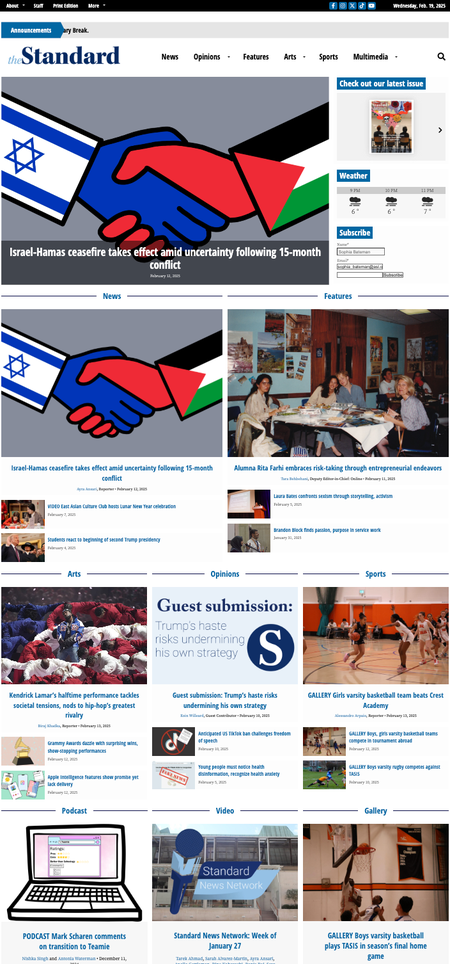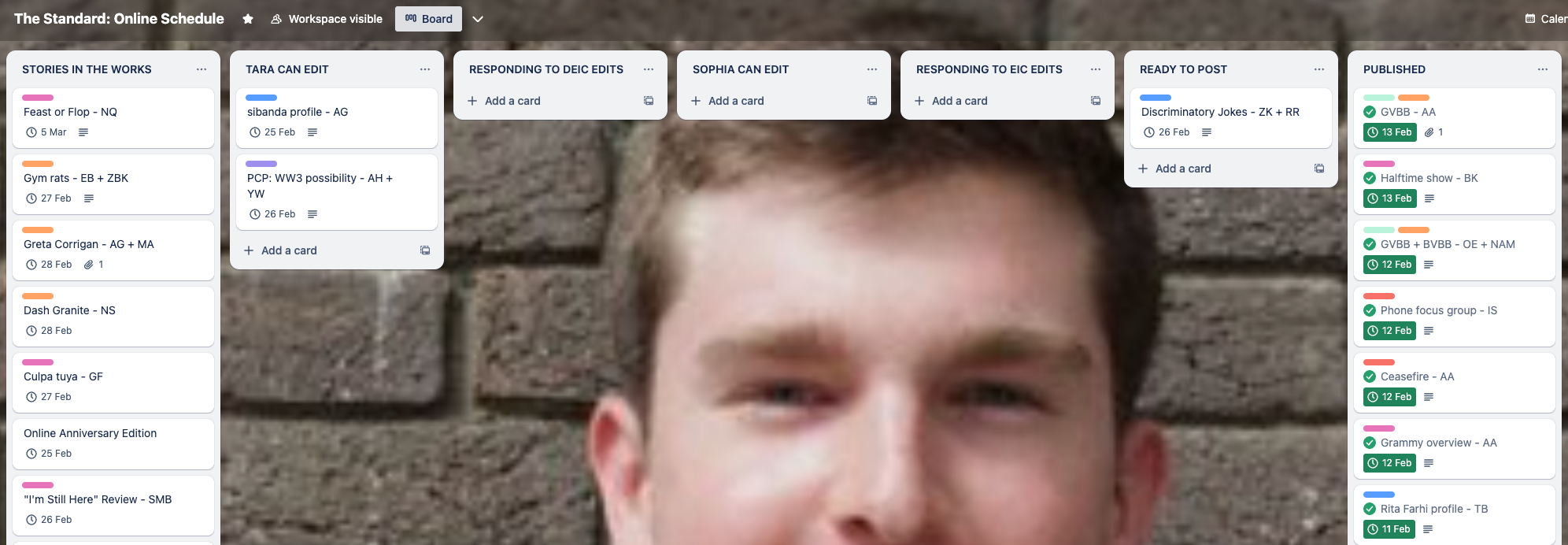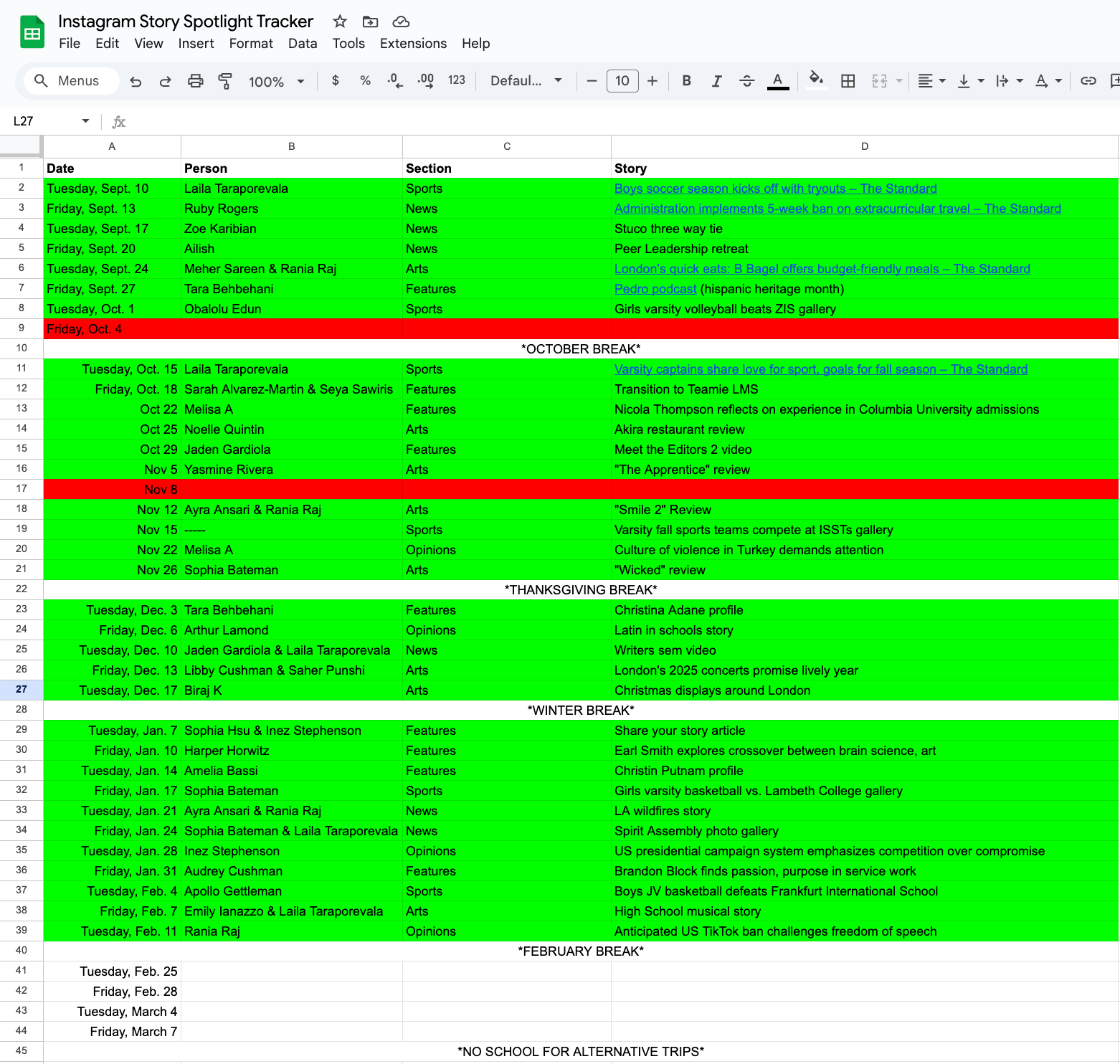

I format a basketball gallery on the backend of our website Feb. 12.
When I took on my role, I realized that while our site had evolved visually over the years, its core functionality had remained unchanged. Inspired by the online presence of several college newspapers like The Michigan Daily and The Dartmouth, I set out to overhaul several aspects of our site. My goal was to enhance accessibility and improve the flow of information, creating a more intuitive and engaging experience for our readers. In addition to changing the site's appearance, I fixed the categorization and exclusion options in the widgets to avoid repetition of stories on the homepage, as seen below.
Throughout the redesign process, I presented my progress to our editors' class, recognizing that gathering feedback is crucial for fostering a collaborative team dynamic and boosting productivity. This open dialogue allowed me to refine my approach and ensure that the final product truly met the needs of our community.

I also created a custom layout for our sports section, which we had never done before with any page. This way, readers can more easily find what they're looking for — a written article, photo gallery, game scores or a livestream. Click on the image below to view our new sports page.

Recently, I learned that we are finalists for the 2025 NSPA Online Pacemaker — our first time earning this recognition since we won in 2021. After several years without recognition in this category, being named a finalist feels like a significant accomplishment and a reflection of the hard work and innovation our staff has put into elevating our online presence.

We were also shortlisted for Best Website in the Student Press Association's National Awards, a competition almost entirely against publications from universities in the U.K. like KCL, Cambridge and UCL. I attribute these achievements in part to our website redesign and the increased focus we’ve placed on digital content this year.
For a more in-depth look into what I specifically changed on the site — particularly on the homepage — and why, view the Design section. To learn about our website's analytics, visit the Marketing and Audience Engagement section.
Along with the website redesign, I assisted the Deputy Editor-in-Chief: Online with a redesign of The Standard's app over the summer. The app serves as one of the primary ways community members stay informed about our online stories. The changes we made are noted below.
Watch the video here for an overview of what our app now looks like.
I truly don't know what I would do without Trello — It is absolutely essential for managing our daily online posting schedule. The DEIC: Online and I use it to organize stories after they've been submitted to the section editor for initial edits, ensuring that each section meets its quota of at least one story per week.
The screenshot below of our mid January to early February posting plan shows how we use color-coding and reporter initials to keep everything clearly organized. This system not only helps us maintain consistency in our content but also streamlines communication during our online posting meetings in class.

In addition to Trello's calendar feature, I rely on the board to visualize each story's progress through the editing process. Our workflow requires that stories be submitted to the DEIC: Online by 8 p.m. the night before they’re scheduled to get published, and once submitted, they must go through both her edits and mine to be published by the end of the following day. This part of the board is crucial because it ensures that the DEIC: Online and I are always aligned and can work quickly to meet our deadlines.
Below are examples of my communication with my lovely DEIC: Online. We constantly communicate about stories and support each other by dividing the responsibility of formatting and publishing stories on the website equally, accommodating to each other's schedules when one of us has a particularly busy day or week. This collaborative dynamic is essential not only for a smooth workflow but also for fostering the trust and teamwork that drive our publication's success.

During each class, we dedicate 15 minutes to planning our posting schedule for the week. The DEIC: Online and I alternate classes where we screen share the Trello board to our room's TV, inviting section editors to update us on scheduled stories and add any new ones to the calendar. Click the video below to see a portion of online posting during our class Jan. 24.
This year, we've reached impressive milestones, such as setting a record for posting eight stories in one day, and our overall content output has increased dramatically. While I will always prioritize quality over quantity, our steady refinements throughout this year and in years past — along with the growth of our staff to 89 members — have enabled us to boost productivity without sacrificing excellence.
Below is a side-by-side comparison of our online posting calendar in November 2023 and November 2024, showing an increase from 21 stories in 20 school days to 40 stories in 17 school days.

As of March 15, we’ve maintained a streak of over 35 consecutive days of online posting without missing any — the longest in The Standard’s history.
When I took on my role of Editor-in-Chief: Online, I revamped our Online Posting Process document and shared it with the Editorial Board. This guide details sectional posting days that we aim to stick to, as well as a general description of the editing flow that I wrote. With the incoming 2024-25 Editorial Board having significant changes — for example, no lead editors and two EICs rather than one — I knew clarity was essential for us to start the year on a good note.
Additionally, as the Lead Features Editor last school year, I collaborated with the Features Editor: Online to ensure our section consistently had at least one story ready to post each week. My section list was my holy grail — I updated it daily to keep a close eye on every story's progress through our rigorous editing process. Below is a snapshot of my section list from March 2024.
In today's digital age, multimedia is crucial for breathing life into our online stories. By requiring the integration of interactive elements in every online story, we not only capture our audience's attention but also provide a richer, more immersive experience.
Our approach to multimedia starts at the idea stage: every story pitch on our story ideas spreadsheet must include a plan for at least one multimedia element. Section editors will not approve a story until the reporter fills out that column. This commitment to multimedia helps us meet the evolving expectations of digital readers and sets our work apart in a crowded online space. See the spreadsheet below.

When I created the 24-25 Story Ideas spreadsheet at the beginning of the school year, I linked our Multimedia Tools document to the multimedia column to help reporters brainstorm ideas.
In addition, multimedia is listed as a requirement in the online writing checklist reporters follow on FLOW, and I frequently remind them to include multimedia in their stories.

Below are some examples of my own multimedia I've created for a few of my published stories. Click on each one to view a reflection and a link to the article on The Standard's website.
The multimedia piece I’m most proud of, however, is my story on sexism within our high school community. This piece not only earned a Best of SNO but also secured Fifth Place in the NSPA Spring Clips & Clicks Feature Story category and Third Place in the NSPA Multimedia Feature Story of the Year at the 2024 NHSJC in Philadelphia. To read the full story, click here. Browse the gallery slideshow below to explore the range of multimedia elements I incorporated into the story.
I wanted to push my storytelling further by adding movement and visual interest to the online article — something that would really grab readers’ attention the moment they arrived on the page. That’s why I decided to create a GIF featured image, a first in The Standard’s history. By layering and animating various newspaper headlines related to gender divides, sexism in schools and Andrew Tate’s influence, I aimed to visually convey both the depth and urgency of these issues.
Now, I've coached other writers in creating their own GIF featured images. Click the images below to find a description with the links to the writers' final featured images.

This year, we have massively expanded our broadcast section through the addition of a Broadcast Editor on the 2024-25 Editorial Board. Since it’s now its own section, I created a separate tab for it on our Story Ideas spreadsheet, which enables us to better organize and plan video coverage of events.
While I’m relatively new to broadcast journalism compared to writing, I have produced several videos for our publication, as shown below. I chose this medium because certain events, like Late Cafe’s musical performances, are far better captured through visuals and sound than text alone. To explore my individual work and journey in more detail — with reflections of each video — visit the Broadcast Journalism section.
Recognitions: Best of SNO (2025)
Recognitions: Best of SNO (2024)
This year, I transitioned our podcast hosting from SoundCloud to Spotify, as it offers a cleaner interface, a simpler upload process and broader reach given its popularity among our audience. The switch has made our audio content more accessible and engaging for listeners.

I have also produced my own timely audio content for our website, as shown by the podcast below. The published version on our website can be viewed here. Similar to above, you can read a more in-depth reflection into my audio stories in the Broadcast Journalism section.
Recognitions: Best of SNO (2024)
Live streaming sports games is a relatively new addition to The Standard, launched just a few months before I stepped into the role of Editor-in-Chief: Online. This year, I’ve worked to grow this platform alongside a dedicated reporter, Noelle, who has a strong interest in sports broadcasting. The Standard has produced more livestreams this year than in any previous year, as shown below. While I’d love to see this area expand further, limited interest has made it more of a niche endeavor — but I’ve encouraged reporters to step outside their comfort zones and explore the unique opportunities live broadcasting offers.

Noelle also created a Livestream Guide, which I edited and added to our Standard Everything Guide to make it easily accessible for the rest of our staff. By integrating it into our central resource document, I aimed to encourage more reporters to get involved and make live streaming a more approachable and sustainable part of our coverage.
When I came across SNO's live coverage feature, I immediately knew this reporter would be interested in exploring it. Live coverage is essential because it connects our audience with real-time events, providing an authentic and engaging perspective that elevates our storytelling. I reached out to her, and we’re now planning to debut this feature during her next livestream.
To keep our site dynamic and engaging, I utilize a range of story templates offered by Student Newspapers Online. From long-form chapter formats to infoboxes, the Deputy Editor-in-Chief and I utilize these tools to distinguish stories. For example, longer, in-depth pieces will typically be formatted in the immersive photo or immersive half photo template.

This year, I've led the creation of four online packages that go beyond traditional storytelling. Each package incorporates interactive elements — like videos and interactive infographics — to deliver an immersive experience. By presenting multiple perspectives on a single topic, these packages not only showcase diverse journalistic approaches but also invite the audience to explore subjects in depth. Click on each image below to explore each package.
Our Summer 2024 Rewind package included the most number of stories The Standard has ever put in an online package: 18. I formatted it using WordPress's grid feature and ensured each story featured some sort of interactivity — and that the multimedia was varied from story to story to reduce repetition.
Below, you'll find just a few examples of multimedia elements included in reporters' stories from the Summer 2024 Rewind package with descriptions. Click the image to view the full story and use the side arrows to view all of them.

In our hybrid Election Special Edition, I ensured every story included some form of interactivity. Since this package took place during the school year — unlike the Summer 2024 Rewind package where most of the writing took place in August before school started — reporters were able to utilize the school's equipment to create podcasts, yet another form of multimedia and alternative storytelling that enhances the user experience.
For our package about our publication's trip to Philadelphia for the NHSJC, I again utilized the grid format on WordPress. This time, we included two videos, three photo galleries and three stories with interactive elements.
Our fourth package so far this year was a hybrid edition that spotlighted The Standard's 50th anniversary. The online version allowed us to elevate the coverage through multimedia elements — incorporating archived stories with images and interactive embeds to showcase the publication’s history in a dynamic way.
After editor turnover on May 1, 2024, the responsibility of becoming a SNO Distinguished Site fell to me and my Deputy Editor-in-Chief: Online. With about two weeks left until the deadline and three out of six badges still missing, we worked tirelessly to meet the criteria, ultimately succeeding just days before the cutoff.
This year, I vowed not to leave the same responsibility to the next EIC: Online and DEIC: Online. So, I set a goal for The Standard to become a SNO Distinguished Site before the end of the first semester — the earliest in our publication’s history. While awards aren’t the only benchmark of our success, I knew The Standard was fully capable of reaching this milestone early, which would spare future editors unnecessary stress. I stayed diligent and methodical, documenting each step in the SNO Distinguished Site Plan I created shown below.
The Standard was named a SNO Distinguished Site Dec. 10, 2024 — a week before the end of the first semester. SNO even asked us if they could use the design draft I created as an example of what they're looking for in the Site Excellence badge after we got it approved on our first try.

Through this process, I learned the value of proactive leadership, organization and collaboration. Learn more about my communication and leadership in the Editing, Leadership and Team Building section.
I've been interning at Newsreel, an interactive news app startup aimed at increasing news literacy and combating news avoidance, for exactly a year now after cold-emailing its founder. Since starting as an intern, I've been tasked with various assignments, including contributing to Newsreel's social media and app.
Now, I get paid to write stories for the app twice a week. Because Newsreel emphasizes timely coverage, I receive my story assignment or pitch a story at around 9 p.m. and work quickly so I can file the story before going to bed (Newsreel is located in a U.S. time zone). By the time users open the app the next morning, they’re greeted with fresh, digestible news supported by relevant multimedia. Click on each image below to see a screen recording of me swiping through one of my stories paired with the text where I receive my assignment. Learn more about my experience at Newsreel in the Law, Ethics and News Literacy section and the Reporting and Writing section.
This year, the Social Media Editor and I also met to redesign our Instagram, which has gone through several changes over the last few years. We opted to create a minimalistic design, only including the title of the event and a small logo in the upper right hand corner for a cleaner look. To differentiate between events and sports games, we created two templates — one in navy and one in orange.
Below are the designs from the last few years, as well as a comparison of our feed last school year vs. this school year. Please note that the square template fit perfectly until Instagram changed its grid layout to be more rectangular!

During the redesign process, we also developed custom covers for each highlight, giving our profile a more polished and cohesive appearance, unlike before when each highlight looked different.

Our Instagram account's primary purpose is event coverage. Reporters sign up to report on events through our story ideas spreadsheet, and every post is edited by both the Social Media Editor and myself to maintain quality and consistency. We also post event coverage either on the day of the event or the following day, ensuring our audience gets timely updates, and our aim has been to post three times a week. Throughout my four years on The Standard, I've contributed significantly to our Instagram account, and the examples below highlight just a few of my contributions from this year.
Below is the event coverage spreadsheet I help the Photography Editor and Social Media Editor on a daily basis. To create an Instagram post, reporters sign up for events here. Having all events in one place like this helps us streamline content creation.
While we already tease our online stories on Facebook, X and Bluesky, at the beginning of the year I noticed that while Instagram is the platform most frequented by our high school audience, we weren't fully leveraging it to promote our content. That insight led me to create "Story Spotlights," a dedicated series of stories designed to showcase our best online work. I met with the Social Media Editor, and we developed a custom template for these stories, which are now featured on our profile every Tuesday and Friday and saved in a dedicated highlight. This initiative has not only increased our engagement but also ensured that our online content reaches more students.
I make it a priority to diversify our content — and that includes Story Spotlights. I created and manage the spreadsheet below to keep track of sections and writers, ensuring we vary them week by week as our online posting schedule allows.
Much like why I created our Story Spotlights, I noticed that our weekly broadcast, Standard News Network, wasn’t getting the promotion it deserved across our social media channels. To address this, I collaborated with the Social Media Editor to design a dedicated template, which we now use every Monday to highlight new SNN episodes. Below are a few examples of these posts. For more on how I’ve boosted SNN’s visibility at our school, check out the Marketing and Audience Engagement section.
In addition, during each sports livestream, we promote the link on an Instagram story. Below is an example from our most recent livestream — We have found this to be an effective way of utilizing social media to enable our online content to reach more people. These stories are then saved to the Livestreams highlight on our profile.

With each new print issue's distribution, I also make sure we promote it on our Instagram story. In the third example below, we even linked to the online version of the Election Special Edition to increase engagement.

Barely awake at 4:30 a.m., I set out to capture ASL's annual Senior Sunrise tradition in a way that truly conveyed the excitement and sense of unity among the senior class. With the music and bubbly ambiance, I thought no better way to cover it but through an Instagram reel, which allowed me to share the moment in a highly engaging and immediate way with students. While battling some severe sleep deprivation, I edited the video, addressed edits from the Social Media Editor and published it on the same day. Click the image below to watch the reel.
The result was one that I am immensely proud of, especially considering it is one of the only reels The Standard has ever published. Hearing enthusiastic feedback from both students and parents made it all worth it, and that was reflected in the analytics — This reel remains The Standard's most viewed Instagram post with almost 3,000 views and 12 hours of watch time, and it's also our third most liked post. To ensure continuity with the rest of our Instagram feed, I also designed a cover for the video that would match our regular posts.

I plan to make a similar reel during Senior Sunset in June, when Grade 12 students once again gather at Primrose Hill, this time wearing their college shirts. Using the lessons I learned from my Senior Sunrise reel and other broadcast experience this year, I will record interviews farther from the top of the hill to decrease background noise and overlay b-roll during interviews. To learn more about my experience with broadcast, visit the Broadcast Journalism section.
To direct more viewers to our site, we publish "social media blurbs" on our Facebook, X and Bluesky accounts that tease online stories. This is a required component that reporters must include when writing a story for our website.
Recognizing Bluesky’s growing momentum in the latter half of 2024, I took the initiative to create an account for The Standard, ensuring our publication had a presence on this emerging platform.

To learn more about our social media analytics, view the Marketing and Audience Engagement section.
This year has also seen growth in our TikTok account. Reporters pitch ideas on a designated section of our story ideas spreadsheet that the Social Media Editor then approves or rejects.

Below, see examples of a few TikToks we have published since editor turnover last May — Hover over them to see their analytics.
The MediaWise Teen Fact-Checking Network is a group of teenagers who get paid to use social media to debunk viral misinformation and share media literacy tips. Since being accepted to the network in July 2024, I've created several fact-checking videos for their various social media platforms. Click on each image below to view the Instagram reel. Each fact check was also published on Facebook, X and TikTok, amassing over 16,500 views total.
Read more about my experience and the process behind creating each video in the Law, Ethics and News Literacy section.
I have also taken part in network-wide videos in celebration of Student Press Freedom Day, which was in collaboration with the Student Press Law Center, and Media Literacy Week. Click on the images below to watch.
Since starting as an intern at Newsreel, I've been tasked with various assignments, including contributing to Newsreel's Instagram and TikTok.
Below is an example of one of these assignments — a video about the "Show me something in your house that tells me who you're voting for" social media trend. It was published on both platforms, both of which are show below. To learn more about my work with Newsreel, including the stories I have written for the app, visit the Reporting and Writing section or Law, Ethics and News Literacy section.





